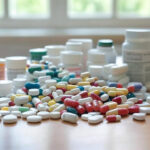Explosive trace detection systems at airport checkpoints are designed to identify minute quantities of explosive materials through techniques such as ion mobility spectrometry. However, their high sensitivity comes at a cost: False-positive alarms can occur when common substances chemically resemble explosive agents. In dermatology, this includes topical medications and moisturizers containing glycerin or nitrates, compounds that are chemically similar to nitroglycerin, a key component of dynamite.
Glycerin is a common humectant found in emollients and ointments prescribed for xerosis, eczema, and other chronic skin conditions. Nitrate-containing topicals, such as nitroglycerin paste, are also used in dermatologic care, particularly for chronic anal fissures or vascular ulcers. These substances can leave behind trace residues on patients’ hands or belongings, sometimes setting off alarms at security checkpoints. Since these products are routinely prescribed in dermatology, especially in hospital-based, wound care, or procedural settings, the issue has direct clinical relevance.
Several real-world incidents illustrate this problem. In 2013, an Oklahoma traveler reported that her glycerin-containing hand lotion triggered a false-positive explosive alarm, leading to extended secondary screening. In another report, a paramedic noted that his bag tested positive for nitroglycerin residue, likely due to carrying nitroglycerin spray used to treat patients with chest pain. In Canada, similar situations have occurred, with CATSA representatives confirming that everyday items like cosmetics and medical creams are among the known triggers of false-positive results. A German case report also described a flight crew member whose glycerin-based moisturizer caused a positive test during routine screening.
Although these events are relatively rare, they can have meaningful consequences. Passengers may face delays, invasive searches, public embarrassment, or even missed flights, particularly those with chronic conditions requiring topical therapies. For dermatologists, this highlights an often-overlooked consideration: How the treatments we prescribe may have unintended effects outside of clinical settings. It also emphasizes the importance of being aware of the broader context in which our patients use these products.
Given how infrequently this occurs, it may not be practical for dermatologists to routinely counsel patients about this risk. However, raising awareness of this phenomenon may still be warranted, especially for patients using high-risk compounds who are frequent travelers. Public education and packaging warnings may help inform users about the potential for false alarms. Future research is also needed to establish the minimum detectable quantities of these compounds by airport scanners and determine whether certain formulations or application sites pose greater risk.
In summary, although uncommon, the potential for dermatologic ointments to trigger false-positive explosive detection highlights an overlooked intersection between skin care and airport security. Increased awareness among prescribers, patients, and regulatory bodies could help minimize unnecessary distress and refine screening protocols. As dermatologists are often the prescribers of these topical agents, understanding this phenomenon remains a relevant, although rare, component of comprehensive patient care.
Eva M. Shelton is a dermatology resident. Janmesh Patel is a medical student.
















![Rebuilding the backbone of health care [PODCAST]](https://kevinmd.com/wp-content/uploads/Design-3-190x100.jpg)


![Why your midlife choices will define your future health [PODCAST]](https://kevinmd.com/wp-content/uploads/Design-2-190x100.jpg)
